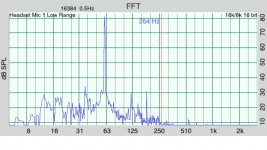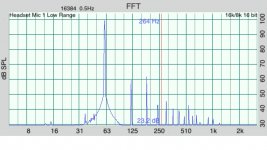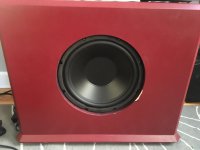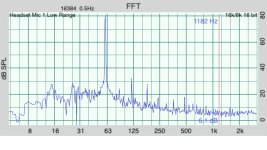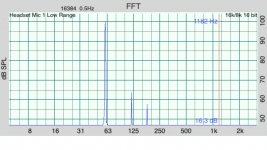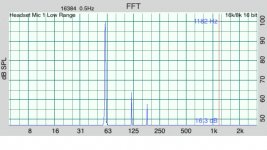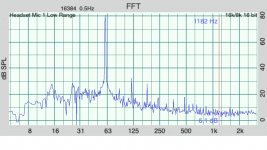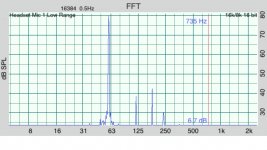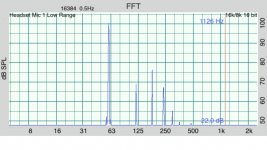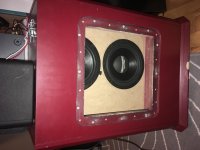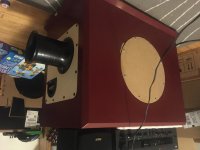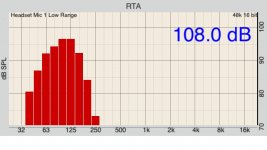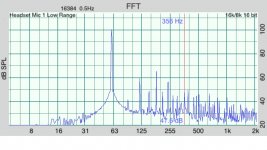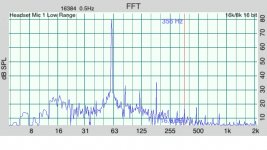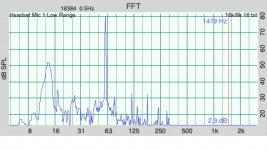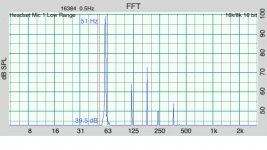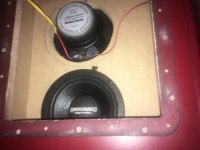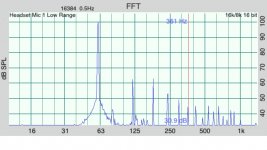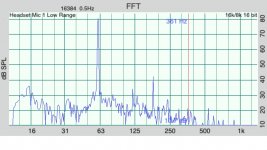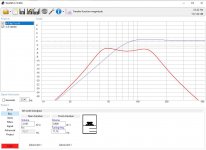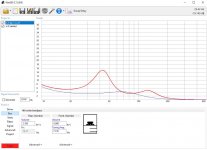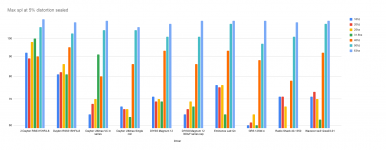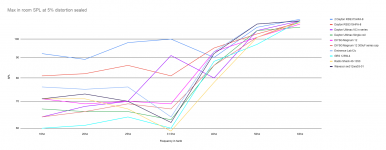Keeping up with the thread namesake next up is another $15 sub, this time a little more modern. This is an open box GRS 12SW-4 a budget 12" sub from Parts Express.
With a Qts of .98 this alignment would be in a textbook of how not to design a vented box, however using the eq on my plate amp I was able to get decent sound out of this. Doesn't have the upper bass detail or slam of others but you can get decent spl.
In fact you can squeeze 5db more output at 31.5hz than a single dayton rs 12 sealed albeit using the leverage of the port.
Here's the distortion measurements:
Frequency Spl of fundamental 2nd harmonic 3rd harmonic
16 56 -36 -20
20 69 -32 -28
25 79 -38 -24
31.5 85 -26 -53
40 92 -23 -26
50 101 -31 -25
63 110 -26 -37
attached is 60hz @80db and 100 db
With a Qts of .98 this alignment would be in a textbook of how not to design a vented box, however using the eq on my plate amp I was able to get decent sound out of this. Doesn't have the upper bass detail or slam of others but you can get decent spl.
In fact you can squeeze 5db more output at 31.5hz than a single dayton rs 12 sealed albeit using the leverage of the port.
Here's the distortion measurements:
Frequency Spl of fundamental 2nd harmonic 3rd harmonic
16 56 -36 -20
20 69 -32 -28
25 79 -38 -24
31.5 85 -26 -53
40 92 -23 -26
50 101 -31 -25
63 110 -26 -37
attached is 60hz @80db and 100 db
Attachments
Guerilla,
All passive filters have a phase shift around the cut off frequency, 90 degrees per filter order, or 6dB per octave. A sealed enclosure behaves as a second order high pass filter, a bass reflex enclosure as a fourth order, so 180 resp 360 degrees.
The point where the response is minus 3dB is called the cut off frequency, and this is tha half way point for the phase shift, and also the point where the rate of change of the phase shift is largest.
So, the farther you place the cut off frequency of your loudspeaker below the bass frequencies that are of musical interest, the lesser phase shift you will encounter at those frequencies.
All passive filters have a phase shift around the cut off frequency, 90 degrees per filter order, or 6dB per octave. A sealed enclosure behaves as a second order high pass filter, a bass reflex enclosure as a fourth order, so 180 resp 360 degrees.
The point where the response is minus 3dB is called the cut off frequency, and this is tha half way point for the phase shift, and also the point where the rate of change of the phase shift is largest.
So, the farther you place the cut off frequency of your loudspeaker below the bass frequencies that are of musical interest, the lesser phase shift you will encounter at those frequencies.
Guerilla,
All passive filters have a phase shift around the cut off frequency, 90 degrees per filter order, or 6dB per octave. A sealed enclosure behaves as a second order high pass filter, a bass reflex enclosure as a fourth order, so 180 resp 360 degrees.
The point where the response is minus 3dB is called the cut off frequency, and this is tha half way point for the phase shift, and also the point where the rate of change of the phase shift is largest.
So, the farther you place the cut off frequency of your loudspeaker below the bass frequencies that are of musical interest, the lesser phase shift you will encounter at those frequencies.
I think so, as in dragging the vented box port tuning below the drivers Fs for a Qts? At a certain point (below, equal or slightly above even, the excursion starts trading ouput as group delay and excursion beyond good BL or the cause an affect of either heat or mechanical issue restricts much of what might be possible far below quickly apparent and issues otherwise?
But, maybe, its reasonable and legitamate to make a big bass reflex tuned way low and sneak in and not abuse the idea(with a max rated power and output and 10 hz...) successfully? The port wont even get truely used, its not reaching that helmholtz, its just a pressure release in case of emergency or a leaky one that never reaches the danger setting as port air mass? Meanwhile the sealed small volume would have required input levels that were ‘worse’ and would have been for the driver and distortion was long ago already part of the deal...
Next up is the GRS in 3 cu ft sealed.
Less output than the old radioshack except at 40hz and 63hz.
Not a bad sub you just get what you pay for.
If you have room you could have strength in multiples.
Here's the distortion measurements:
Frequency Spl of fundamental 2nd harmonic 3rd harmonic
16 60 -35 -25
20 61 -35 -26
25 64 -28 -24
31.5 60 -20 -29
40 88 -25 -26
50 97 -36 -25
63 111 -26 -33
attached is 60hz @80db and 100 db
Less output than the old radioshack except at 40hz and 63hz.
Not a bad sub you just get what you pay for.
If you have room you could have strength in multiples.
Here's the distortion measurements:
Frequency Spl of fundamental 2nd harmonic 3rd harmonic
16 60 -35 -25
20 61 -35 -26
25 64 -28 -24
31.5 60 -20 -29
40 88 -25 -26
50 97 -36 -25
63 111 -26 -33
attached is 60hz @80db and 100 db
Attachments
Last test for the GRS is the 3 cuft passive 17.4hz tune. Too low a tune to get much output.
Here's the distortion measurements:
Frequency Spl of fundamental 2nd harmonic 3rd harmonic
16 71 -25 -30
20 76 -36 -26
25 74 -28 -25
31.5 55 -20 -28
40 87 -26 -27
50 100 -35 -24
63 110 -25 -39
attached is 60hz @80db and 100 db
Here's the distortion measurements:
Frequency Spl of fundamental 2nd harmonic 3rd harmonic
16 71 -25 -30
20 76 -36 -26
25 74 -28 -25
31.5 55 -20 -28
40 87 -26 -27
50 100 -35 -24
63 110 -25 -39
attached is 60hz @80db and 100 db
Attachments
The next set of tests will demonstrate the effectiveness of using push-pull driver arrangement and 4th order bandpass for distortion reduction.
When I cut out the partition between the driver cavity and the plate amplifier cavity I cut 2 7" diameter holes. This allowed me two mount 2 old radio shack DVC subwoofers 40-1348. This should be a good driver for this test because it does a good job of producing distortion!
This setup is then a sealed cavity of 2.1 cu ft and ported cavity of .9 cu ft with a 4" diameter by 4.5" long flared port.
The first test was with out the front cover so basically two 8 inch subs in 2.1 cu ft sealed with standard mounting.
Here's the distortion measurements:
Frequency Spl of fundamental 2nd harmonic 3rd harmonic
16 70 -26 -25
20 56 -31 -19
25 64 -24 -34
31.5 55 -20 -31
40 56 -20 -25
50 91 -26 -37
63 99 -30 -25
attached is 60hz @80db and 100 db
When I cut out the partition between the driver cavity and the plate amplifier cavity I cut 2 7" diameter holes. This allowed me two mount 2 old radio shack DVC subwoofers 40-1348. This should be a good driver for this test because it does a good job of producing distortion!
This setup is then a sealed cavity of 2.1 cu ft and ported cavity of .9 cu ft with a 4" diameter by 4.5" long flared port.
The first test was with out the front cover so basically two 8 inch subs in 2.1 cu ft sealed with standard mounting.
Here's the distortion measurements:
Frequency Spl of fundamental 2nd harmonic 3rd harmonic
16 70 -26 -25
20 56 -31 -19
25 64 -24 -34
31.5 55 -20 -31
40 56 -20 -25
50 91 -26 -37
63 99 -30 -25
attached is 60hz @80db and 100 db
Attachments
Next up is the same radioshack 8" drivers with the cover installed so this is a 4th order bandpass with both magnets in the sealed section. I've attached the pink noise RTA at the port. It's approximately a 50-120hz passband.
I had to stop the 50 and 63hz distortion measurements before I hit 5% distortion in the 2nd and 3rd harmonics as I was getting so much mechanical noise from the drivers that I was worried they would self destruct.
Here's the distortion measurements:
Frequency Spl of fundamental 2nd harmonic 3rd harmonic
16 70 -24 -29
20 65 -25 -34
25 64 -24 -40
31.5 64 -23 -43
40 70 -25 -39
50 102 -30 -40
63 100 -35 -30
attached is 60hz @80db and 100 db and pink noise at the port.
I had to stop the 50 and 63hz distortion measurements before I hit 5% distortion in the 2nd and 3rd harmonics as I was getting so much mechanical noise from the drivers that I was worried they would self destruct.
Here's the distortion measurements:
Frequency Spl of fundamental 2nd harmonic 3rd harmonic
16 70 -24 -29
20 65 -25 -34
25 64 -24 -40
31.5 64 -23 -43
40 70 -25 -39
50 102 -30 -40
63 100 -35 -30
attached is 60hz @80db and 100 db and pink noise at the port.
Attachments
Ok next up is the same radio shack 8s sealed in push pull orientation.
More output 40hz-63 than the standard sealed but less below 31.5hz. However, with levels this low 50-60 db in the low bass I'm fighting against the noise floor so I wouldn't focus on this.
Here's the distortion measurements:
Frequency Spl of fundamental 2nd harmonic 3rd harmonic
16 54 -35 -18
20 51 -27 -20
25 56 -21 -34
31.5 55 -20 -33
40 73 -26 -28
50 99 -39 -22
63 100 -40 -27
attached is 60hz @80db and 100 db
More output 40hz-63 than the standard sealed but less below 31.5hz. However, with levels this low 50-60 db in the low bass I'm fighting against the noise floor so I wouldn't focus on this.
Here's the distortion measurements:
Frequency Spl of fundamental 2nd harmonic 3rd harmonic
16 54 -35 -18
20 51 -27 -20
25 56 -21 -34
31.5 55 -20 -33
40 73 -26 -28
50 99 -39 -22
63 100 -40 -27
attached is 60hz @80db and 100 db
Attachments
Final test in this series is keeping the push-pull orientation and with the cover. So it's a 4th order bandpass with the drivers in push-pull.
I wish I could live with the sound of this setup, the distortion is low but with the increased group delay and stored energy of the bandpass alignment every bass note sounds the same, kick drum, bass guitar, taiko drum are all just BOOM. Of the 4 variations using this driver the push-pull sealed variant sounded the best to me with music.
Again I capped the 50 and 63hz measurements off at 100db as I was getting a ton of mechanical noise. At 50 hz 5th order distortion is highest distortion product at -42db.
Here's the distortion measurements:
Frequency Spl of fundamental 2nd harmonic 3rd harmonic
16 65 -41 -20
20 76 -30 -24
25 80 -25 -24
31.5 76 -25 -29
40 78 -25 -42
50 100 -49 -50
63 100 -38 -35
attached is 60hz @80db and 100 db
I wish I could live with the sound of this setup, the distortion is low but with the increased group delay and stored energy of the bandpass alignment every bass note sounds the same, kick drum, bass guitar, taiko drum are all just BOOM. Of the 4 variations using this driver the push-pull sealed variant sounded the best to me with music.
Again I capped the 50 and 63hz measurements off at 100db as I was getting a ton of mechanical noise. At 50 hz 5th order distortion is highest distortion product at -42db.
Here's the distortion measurements:
Frequency Spl of fundamental 2nd harmonic 3rd harmonic
16 65 -41 -20
20 76 -30 -24
25 80 -25 -24
31.5 76 -25 -29
40 78 -25 -42
50 100 -49 -50
63 100 -38 -35
attached is 60hz @80db and 100 db
Attachments
However BP1Fanatic, look at my measured pink noise frequency response which is showing a higher f3. I'm just going by published t/s parameter and hornresp is more accurate than WinISD at modeling bandpass enclosures I would think.
I was playing music while converting the box from the sealed to bp. I could notice a definite degrade in transient response after going to bandpass.
I was playing music while converting the box from the sealed to bp. I could notice a definite degrade in transient response after going to bandpass.
- Home
- Loudspeakers
- Subwoofers
- A tale of 12" subwoofers, distortion and 15 dollars.
